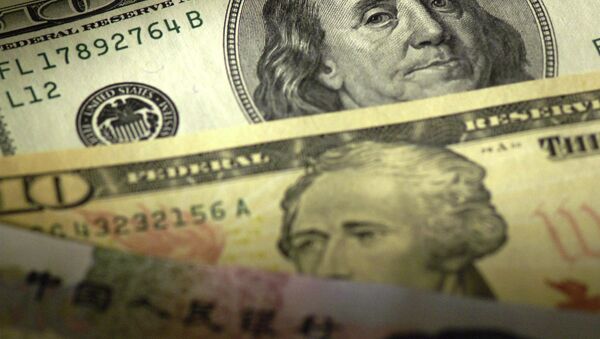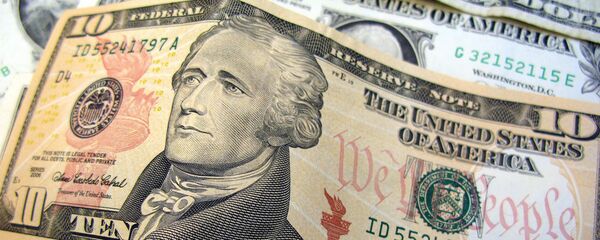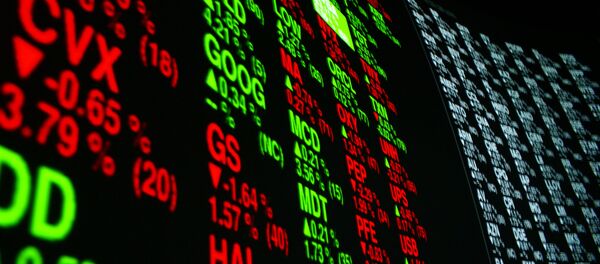Kristian Rouz – Last year’s election of Donald Trump as US President has resulted in a slight devaluation of the US dollar, prompting a jump in the price of other currencies, such as the euro, Mexican peso, the yen and the Russian rouble. An increasing number of currency traders are getting involved in carry trade, buying into higher-yielding emerging market currencies, while others are seeking less volatile safe havens in the $5-trillion global currency market.
Such tendencies might result in even greater imbalances in the international trade in goods and services, adding to Trump-related policy concerns, which revolve around his higher customs tariffs agenda, and renegotiation of the existing structure of global free trade agreements.
Trump’s reputation alone, however, prevents currency market participants from buying into the greenback. The military-industrial complex, which now directs US economic development, is pushing for greater protectionism. A weaker currency is one of the most efficient ways to help domestic producers.
During the last two years of the previous White House administration, the dollar surged significantly, rendering US imports cheaper, and making it hard for domestic companies to compete with their overseas peers within the United States. A stronger dollar also made US exports more expensive, making it even harder for US producers to compete overseas. This ‘double negative’ effect has pushed US corporate sector profitability below zero, and contributed a great deal to Trump’s eventual electoral victory.
In 2016, Trump referred to the US dollar as “too strong.” He said: “Our companies can’t compete with [China] now because our currency is too strong. And it’s killing us.”
Trump, with his intentions to impose high (up to 35-45pc) import tariffs and lower export tariffs to almost zero, is aiming to boost the competitiveness of the US goods and services both at home and abroad. Even though his administration is favouring a quicker normalisation in Fed monetary policies, the White House is likely to pursue a greater devaluation of the national currency through other mechanisms in order to support Trump’s policy agenda.
“This is the first time we have a president-elect say the dollar has gone too far,” Marc Chandler of Brown Brothers Harriman said in January, two days before Trump’s inauguration. “He's saying things and doing things that no president has ever done before."
Policies aimed at dollar devaluation, and the devaluation itself are, however, potentially hazardous to the system of international trade. For example, Mainland China’s effort to lower the renminbi’s FX rate in 2014-2015 in its struggle for competitiveness has produced shockwaves throughout the globe, spurring the ‘war of currency devaluations’, where most emerging markets and even the Eurozone pursued policies similar to those of Beijing.
Most recently, currency traders have started diversifying their portfolios, becoming involved in riskier market practices. For example, as US borrowing costs go up, a currency trader wants to borrow in lower-rate currencies such as the euro (ECB interest rates are zero), or the yen (BOJ rates are —0.1). Then the trades buys into a higher-yielding (and more volatile) currency, such as the Mexican peso, the South African rand, or the Russian rouble. The latters’ FX rates are likely to go up subsequently.
Many of the world’s currencies are gaining in value, thus supporting the dollar’s devaluation to an even greater extent. And this is exactly what Trump would like to see, and it also allows the US Fed to normalise their monetary policies more quickly by raising rates even higher, and further fuelling international carry trade.
However, carry trade has its limits. Once a certain high-yield currency gains too much value, the yields go down. The traders then switches to another currency.
"The carry trade is far more important than the dollar move in changing the currency market," Bob Savage of New York-based hedge fund CCTrack Solutions LLC said. "The rise in the yen may actually put the trade at risk. The dollar itself doesn’t affect the biggest FX trade out there, but the yen does."
What the Trump-inspired dollar slide is doing to international trade in physical goods is impairing other nations’ exporting capacity. A stronger euro, yen, or Mexican peso render the European, Japanese, or Mexican goods less competitive in the international market. Thus the US-made goods gain a competitive edge both at home and overseas. Another factor is: a cheaper dollar pushes global oil prices higher, driving inflation and production costs throughout the world.
US manufacturers benefit from the dollar slide greatly, while the rest of world, facing increased limitations on their access to the international market, will have to rely on domestic consumption as the key driver of their economies.
However, carry trade is a risky and unpredictable practice: many emerging market currencies crashed in 2014 due to the decrease in carry trade activity stemming from the dollar appreciation at the time.
"High-yielding currencies should outperform a basket of low yielders over the near term," Guy Stear, of Societe Generale noted. "Global markets remain enamoured of risk and emerging markets have been no exception."
There is no hedge from the influence of the tidal waves of the dollar’s value in any market economy open to the international flows of capital.
However, the Trumpian era requires greater caution when it comes to monetary policies, macroprudential central bank and governmental policies, and more and efforts to decrease the exposure of the national economy to foreign trade.
Unless you are the one printing the dollars.



